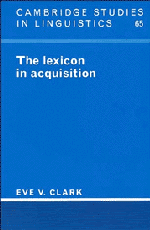Book contents
- Frontmatter
- Contents
- Acknowledgments
- 1 The lexicon: words old and new
- 1 LEXICAL ACQUISITION
- 2 CASE STUDIES OF LEXICAL INNOVATION
- 8 Words for things
- 9 More words for things
- 10 Words for agents and instruments
- 11 Words for actions
- 12 Words for undoing actions
- 3 CONCLUSION
- Bibliography
- Index of names
- Index of subjects
10 - Words for agents and instruments
Published online by Cambridge University Press: 05 July 2011
- Frontmatter
- Contents
- Acknowledgments
- 1 The lexicon: words old and new
- 1 LEXICAL ACQUISITION
- 2 CASE STUDIES OF LEXICAL INNOVATION
- 8 Words for things
- 9 More words for things
- 10 Words for agents and instruments
- 11 Words for actions
- 12 Words for undoing actions
- 3 CONCLUSION
- Bibliography
- Index of names
- Index of subjects
Summary
Agents of actions are typically animate instigators of the activity denoted by the verb. Instruments, in contrast, are typically inanimate, but like agents they play an essential role in effecting an action. Moreover, agent and instrument nouns are common in children's spontaneous coinages (Chapters 8 and 9), so the notions of agent and instrument are clearly accessible to children from an early point in acquisition. This chapter focusses, then, on a single semantic domain in order to compare elicited coinages from English with directly comparable data from Icelandic, Hebrew, French, and Italian. This will allow further evaluation of simplicity, transparency, and productivity in the acquisition of word formation.
Within a language, terms for agents and instruments often share one or more forms in common, and a single affix may serve in coining both noun types. In English, for example, the form pointer could designate a person who points at whoever gets the next turn, or an instrument that points at defective rivets. More specialized devices are available too, ones that serve only for agents, or only for instruments. Compounds with a head noun like -man appear in some established agent nouns (milkman) alongside instrument compounds with -machine (washing-machine). The suffixes -ist and -ian are used only for agent nouns, as in chemist, librarian, while zeroderivation is generally used only for instruments, as in a drill or a whisk. In English, then, there is one suffix common to both agents and instruments (-er), and several other more specialized options.
- Type
- Chapter
- Information
- The Lexicon in Acquisition , pp. 177 - 197Publisher: Cambridge University PressPrint publication year: 1993



